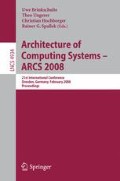Abstract
The adaptation of pervasive applications is in the focus of many current research projects. While decentralized adaptation is mandatory in infrastructureless ad hoc scenarios, most realistic pervasive application scenarios are situated in heterogeneous environments where additional computation power of resource-rich devices can be exploited. Therefore, we propose a hybrid approach to application configuration that applies centralized as well as decentralized configuration as appropriate in the given environment. In this paper we introduce the Direct Backtracking algorithm that represents an efficient way for centralized configuration and adaptation of pervasive applications in heterogeneous scenarios. In our evaluation, we show that compared with other centralized algorithms, our algorithm significantly reduces adaptation latency as it avoids unnecessary adaptations that arise in many other backtracking algorithms, without significantly increasing memory waste. This is achieved by introducing two mechanisms: 1. proactive backtracking avoidance and 2. intelligent backtracking.
Access this chapter
Tax calculation will be finalised at checkout
Purchases are for personal use only
Preview
Unable to display preview. Download preview PDF.
References
Becker, C., et al.: PCOM - A Component System for Pervasive Computing. In: Proceedings of the 2nd IEEE International Conference on Pervasive Computing and Communications (PerCom 2004), Orlando, USA (2004)
Román, M., et al.: Gaia: A Middleware Infrastructure to Enable Active Spaces. In: IEEE Pervasive Computing, pp. 74–83 (October-December 2002)
Sousa, J.P., Garlan, D.: Aura: an Architectural Framework for User Mobility in Ubiquitous Computing Environments. In: Proceedings of the 3rd Working IEEE/IFIP Conference on Software Architecture, August 2002, pp. 29–43. Kluwer Academic Publishers, Dordrecht (2002)
Saif, U., et al.: A case for goal-oriented programming semantics. In: UbiSys 2003: Workshop on System Support for Ubiquitous Computing at UbiComp 2003, Seattle, USA, pp. 1–8 (2003)
Handte, M., Becker, C., Rothermel, K.: Peer-based Automatic Configuration of Pervasive Applications. In: IEEE International Conference on Pervasive Services 2005 (ICPS 2005), Santorini, Greece (2005)
Handte, M., et al.: 3PC/MarNET Pervasive Presenter. In: 4th IEEE International Conference on Pervasive Computing and Communications (PerCom 2006), Pisa, Italy (2006)
Yokoo, M., et al.: The Distributed Constraint Satisfaction Problem: Formalization and Algorithms. IEEE Transactions on Knowledge and Data Engineering 10(5), 673–685 (1998)
Baker, A.B.: Intelligent Backtracking on Constraint Satisfaction Problems: Experimental and Theoretical Results. PhD Thesis, University of Oregon (March 1995)
Brito, I., Meseguer, P.: Synchronous, asynchronous and hybrid algorithms for DisCSP. In: Workshop on Distributed Constraints Reasoning (DCR 2004), Toronto, Canada (September 2004)
Gaschnig, J.: A general backtrack algorithm that eliminates most redundant checks. In: International Joint Conference on Artificial Intelligence, Menlo Park, p. 457 (1977)
Stallman, R.M., Sussman, G.J.: Forward Reasoning and Dependency-Directed Backtracking in a System for Computer-Aided Circuit Analysis. Artificial Intelligence 9, 135–196 (1977)
Ginsberg, M.L.: Dynamic backtracking. Journal of Artificial Intelligence Research 1, 25–46 (1993)
Author information
Authors and Affiliations
Editor information
Rights and permissions
Copyright information
© 2008 Springer-Verlag Berlin Heidelberg
About this paper
Cite this paper
Schuhmann, S., Herrmann, K., Rothermel, K. (2008). Direct Backtracking: An Advanced Adaptation Algorithm for Pervasive Applications. In: Brinkschulte, U., Ungerer, T., Hochberger, C., Spallek, R.G. (eds) Architecture of Computing Systems – ARCS 2008. ARCS 2008. Lecture Notes in Computer Science, vol 4934. Springer, Berlin, Heidelberg. https://doi.org/10.1007/978-3-540-78153-0_6
Download citation
DOI: https://doi.org/10.1007/978-3-540-78153-0_6
Publisher Name: Springer, Berlin, Heidelberg
Print ISBN: 978-3-540-78152-3
Online ISBN: 978-3-540-78153-0
eBook Packages: Computer ScienceComputer Science (R0)

